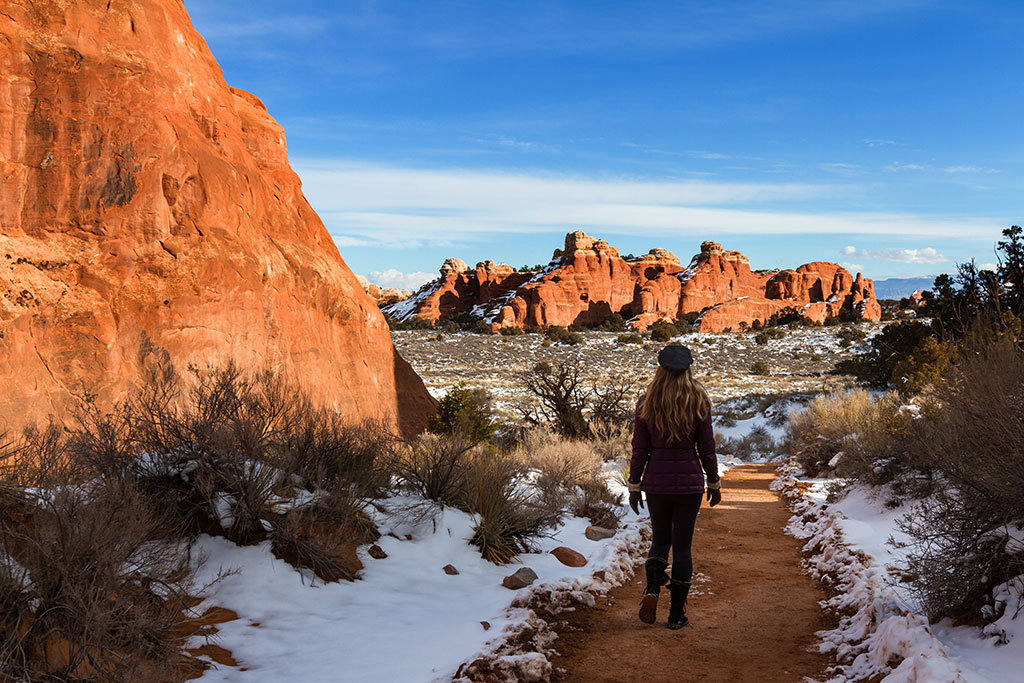Winter Hiking Tips
Winter hiking in Moab offers a unique experience, transforming the iconic red rock landscapes into a winter wonderland. As the temperatures drop, the crowds thin out, providing hikers with a more serene and intimate exploration of the stunning terrain. Trails like the Delicate Arch take on a different allure as they become dusted with snow, creating a picturesque contrast against the red sandstone formations. The crisp winter air adds a refreshing element to the adventure, and the snow-covered canyons offer a tranquil backdrop for those seeking a peaceful escape.
Be Prepared
Winter hiking requires careful consideration of safety measures due to the colder conditions. It’s crucial for hikers to be well-prepared by dressing in layers to combat the cold, carrying sufficient water, and wearing appropriate footwear for potentially icy or snowy trails. Since daylight hours are shorter in winter, planning hikes with ample time for daylight is essential to avoid navigating trails in the dark. Additionally, informing someone about the chosen trail and expected return time is a prudent precaution. Checking weather forecasts before embarking on a winter hike helps anticipate any sudden changes in conditions. Carrying essentials such as a map, compass, and a fully charged phone aids navigation. Moab’s winter landscape is awe-inspiring, but prioritizing safety ensures that hikers can fully enjoy the experience while minimizing potential risks associated with winter conditions.
Check Weather Conditions
Always check the weather forecast before heading out. Winter conditions can change rapidly, and it’s crucial to be prepared for cold temperatures, snow, and possible storms.
Layer Clothing
Dress in layers to regulate body temperature. Use a moisture-wicking base layer, insulating layer for warmth, and a waterproof and windproof outer layer to protect against the elements.
Protect Extremities
Wear insulated and waterproof boots to keep your feet warm and dry. Don’t forget warm gloves or mittens, a hat, and consider using gaiters to keep snow out of your boots.
Use Traction Aids
Carry traction devices like crampons or microspikes to provide better grip on icy or snow-covered trails. This is especially important on steep or uneven terrain. Traction devices are available at gear shops in Moab, such as GearHeads Outdoor Store and Moab Gear Trader.
Carry Essential Gear
Pack essential winter gear, including a map and compass, a headlamp or flashlight, a multi-tool, a first aid kit, extra food, and a thermos with hot drinks. Consider carrying a lightweight emergency shelter.
Stay Hydrated
Dehydration can occur in cold weather, so remember to drink plenty of fluids. Use an insulated water bottle or bladder to prevent liquids from freezing.
Know Sunset Time
Start your hike early and be aware of sunset times. Winter days are shorter, and it gets dark earlier, so plan your hike accordingly to avoid being caught in the dark.
Tell Someone Your Plans
Always inform someone of your hiking plans, including your expected route, estimated return time, and any emergency contacts. This is crucial in case of unexpected situations.
Be Avalanche Aware
If you’re hiking in areas prone to avalanches, check avalanche forecasts, and be knowledgeable about safe practices. Consider taking an avalanche safety course if you plan to explore avalanche terrain.
Stay on Marked Trails
Stick to established trails and avoid shortcuts, especially in snowy conditions. Straying off the path can lead to getting lost or encountering hazards.
Leave No Trace
Practice Leave No Trace principles, even in winter. Pack out all trash, and avoid disturbing wildlife. Winter environments are fragile, and your impact can be more significant.
Winterize Your Gear
Ensure your gear is winter-ready. Check that zippers, closures, and other components are in good working order. Insulate electronic devices to prevent them from losing battery power quickly in the cold.
Stay Informed
Keep an eye on trail conditions, park alerts, and any advisories. Stay informed about the specific challenges and conditions in the area you plan to hike.
https://www.discovermoab.com/winter-hiking-tips/

